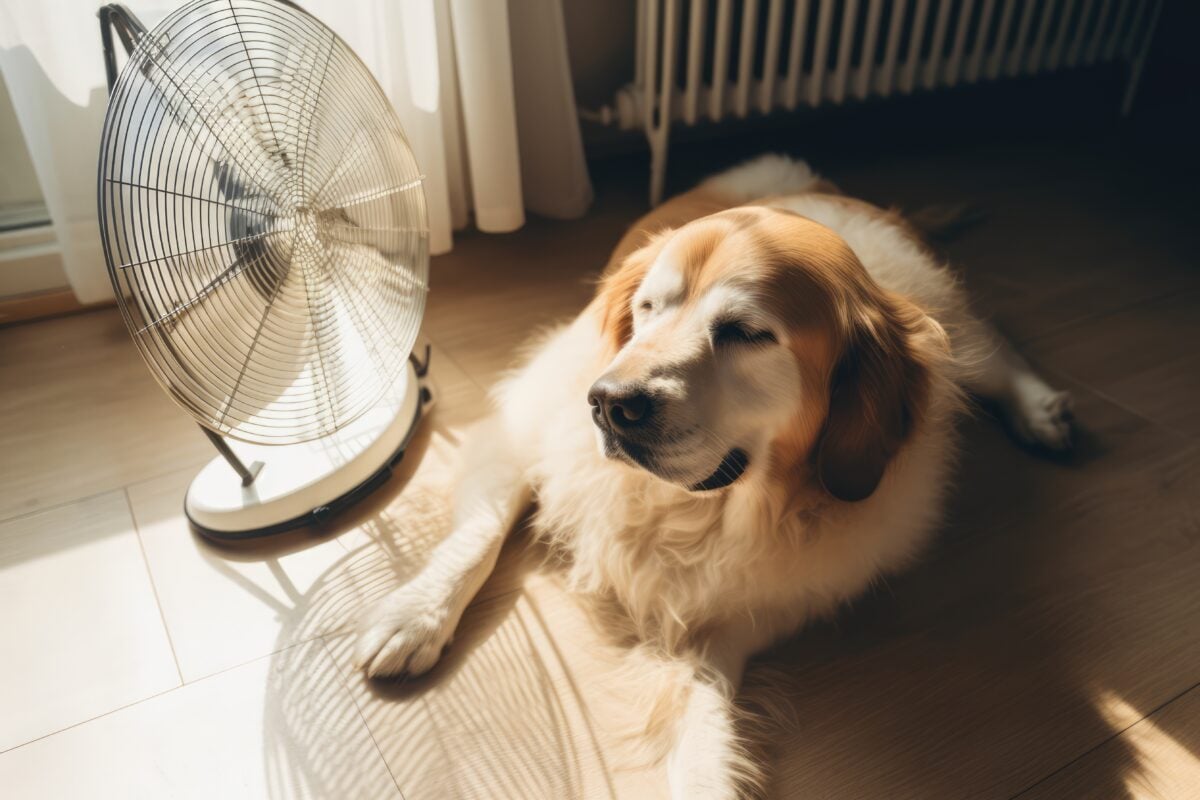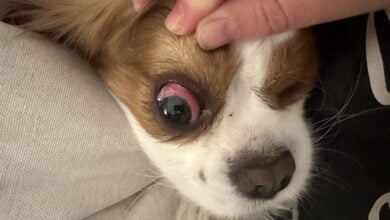Summer Survival Hacks For Dogs: Avoid Heat Stroke Now
When you purchase through links on our site, we may earn a commission. Here’s how it works.
It starts with heavy panting and a tongue hanging out. Heat stroke in dogs can happen fast—and it’s more common than you think.
Table of Contents
When overheating turns serious, you don’t have much time. Learn what to look for, what to do, and how to stop a hot day from becoming an emergency.
Wobbly Walk? These Are The First Red Flags
Panting is normal for dogs. It helps them cool off and sometimes shows excitement. But when panting turns heavy, rapid, or won’t stop, it could mean your dog is dangerously overheated.

Heat stroke in dogs often starts with subtle signs. Catching them early can make all the difference.
Early Symptoms To Watch For
- Excessive panting that doesn’t ease with rest
- Rapid breathing (over 40 breaths per minute)
- Dry, sticky, or bright red gums
- Low energy or unusual sluggishness
- Disorientation or stumbling
Quick check: Count your dog’s breaths for 15 seconds, then multiply by 4. Take action immediately if it’s more than 40 breaths per minute and your dog seems off.
These are early warnings. The following signs are far more serious.
Too Late? Signs Heat Stroke Is Turning Critical
If early warning signs are missed, heat stroke can escalate fast. Once your dog’s internal temperature climbs too high, vital organs are at risk.
At this stage, you’re no longer dealing with discomfort. This is a medical emergency.
Advanced Symptoms Of Heat Stroke In Dogs
If you notice any of these signs, do not wait. Begin cooling your dog immediately and head to the nearest emergency vet.
- Vomiting or diarrhea
- Seizures or muscle tremors
- Collapse or inability to stand
- Loss of consciousness
- Pale gums or gums turning blue
- Weak pulse or rapid heart rate
Minutes can make the difference between survival and organ failure.
Built To Cool: How Dogs Regulate Body Heat
Dogs don’t sweat the way humans do. Instead, they rely on a few limited tools to manage rising body temperature; when those fail, overheating sets in fast.

Here’s How Dogs Naturally Cool Down
- Panting is the main way dogs release heat. Moisture evaporates from their tongue, mouth, and upper airway to help lower body temperature.
- Sweating through their paws helps slightly, but it’s not nearly enough to cool them down during severe heat.
- Blood vessel expansion moves warm blood closer to the skin, allowing heat to escape through the skin and ears.
- Double coats can help insulate against both cold and heat, but if the undercoat becomes packed or matted, it can trap heat instead.
Understanding how your dog cools down—and where that system fails—can help you act faster when things heat up.
Which Dogs Overheat The Fastest?
Some dogs are built to handle heat better than others. Others can tip into dangerous territory in minutes, even on mildly warm days.

Dogs at the highest risk of heat stroke include:
- Flat-faced (brachycephalic) breeds like French Bulldogs, Pugs, Boxers, Boston Terriers, and Shih Tzus. Their short snouts make breathing less efficient, especially during exercise or stress.
- Large or overweight dogs have more body mass to cool and are prone to overheating, even during light activity.
- Thick-coated breeds like Huskies, Malamutes, Chow Chows, and Golden Retrievers. Their coats can trap heat, especially if they’re not well-groomed.
- Senior dogs and puppies regulate temperature less effectively than healthy adult dogs.
- Working and herding breeds like Border Collies, German Shepherds, and Belgian Malinois may push through discomfort and not stop on their own.
If your dog falls into any of these categories, be extra cautious in warm weather. Shade, hydration, and timing outdoor activity can go a long way toward preventing a crisis.
It’s Not Just The Heat — It’s The Humidity
Hot weather is dangerous, but humidity can make it deadly. When the air is full of moisture, panting becomes less effective, and dogs can overheat even at lower temperatures.

Why humidity matters:
- Panting depends on evaporation. In humid conditions, moisture doesn’t evaporate from the tongue or airway as quickly, so your dog struggles to release heat.
- Even at 75 or 80 degrees, high humidity can create conditions that feel like 90-plus degree heat to your dog.
- Heat index charts made for humans do not apply well to dogs. They can reach their limit long before you start to sweat.
If the air feels muggy to you, it is risky for your dog. On humid days, skip the walk and opt for shaded yard time or indoor play instead.
Quick Tip: When To Cancel The Walk
- Temperature over 80°F?
- Humidity above 70 percent?
- Asphalt too hot for your hand?

If you answered yes to any of these, keep your dog indoors or stick to early mornings and shaded areas. Heat stroke can happen faster than you think.
What To Do Right Now If Your Dog Overheats
If your dog shows signs of heat stroke, act fast. Cooling them down quickly—and safely—can save their life.
Step-By-Step Emergency Response
- Move your dog out of the heat immediately. Get them into shade or an air-conditioned space.
- Wet them down with cool (not cold) water. Use a hose, wet towels, or gently pour water over their body. Focus on the chest, belly, armpits, and paw pads.
- Apply cool, damp towels to the head, neck, and between the legs. Swap them out every few minutes so they do not trap heat.
- Use a fan or create airflow to help evaporate heat from the body.
- Offer small sips of cool water. You can also mix in a pinch of salt or a bit of broth to encourage drinking and replace lost minerals.
- Avoid ice or freezing water. Sudden cold can cause blood vessels to constrict and slow down cooling.

Important: If your dog is vomiting, collapsing, seizing, or not responding normally, go to an emergency vet immediately.
A vet visit is still recommended even if your dog seems to recover. Internal damage from heat stroke is not always visible right away.
At the hospital, your vet may provide IV fluids, oxygen, and continuous monitoring to stabilize your dog’s condition.
What Not To Do When Your Dog Is Overheating
When panic sets in, it’s easy to make mistakes. These common reactions can actually make things worse.

- Don’t use ice or freezing water. Extreme cold causes blood vessels to constrict, trapping heat inside the body. Stick to cool (not cold) water.
- Don’t force your dog to drink. If they’re disoriented or unable to swallow normally, forcing water can lead to choking or aspiration.
- Don’t wrap them in wet towels without airflow. This can insulate heat rather than release it. Use damp towels only with a fan or airflow.
- Don’t delay the vet visit. Even if your dog starts to look better, internal damage may already be happening. Heat stroke is always a reason to call your vet.
A calm, informed response is the best chance your dog has to recover fully. Know the signs, act quickly, and avoid these missteps.
Checklist: What To Bring To The Vet
- Your dog’s current temperature (if you were able to take it)
- Timeline of symptoms (when they started panting, collapsed, etc.)
- Any treatments you already tried (cooling towels, water, etc.)
- A damp towel or cooling mat for the car ride
- A water bottle or collapsible bowl in case your dog becomes alert and able to drink
If possible, call the clinic while you’re on the way so they can prepare for emergency care.
Heat-Proof Your Dog’s Day
The best way to handle heat stroke is to prevent it entirely. With a few daily habits and adjustments, you can keep your dog cool, comfortable, and out of danger.
Walk Smart
- Stick to early morning or late evening walks when temperatures are lower
- Test the pavement with your hand. If it’s too hot for you, it’s too hot for your dog’s paws
- Take breaks in shaded areas and avoid intense play during peak sun hours
Watch your dog’s energy, not just the weather. Some dogs won’t stop on their own. High-drive breeds and ball-obsessed pups may push through discomfort, so it’s up to you to call for breaks and limit activity.
Stay Hydrated
Always provide access to cool, fresh water. Try adding ice cubes to the water bowl to make it extra refreshing.

Bring a dog-safe water bottle on walks or trips
Keep Your Home Cool
- Use fans or air conditioning to circulate air
- Give your dog access to cooler surfaces like tile floors
- Never confine your dog in a sun-exposed room, garage, or unventilated area
Plan For Travel & Outdoor Time
- Never leave your dog in a parked car, even with windows cracked
- Use cooling gear like bandanas, vests, or elevated beds for outdoor time
- Provide shade with umbrellas, trees, or pop-up tents if your dog is outside

Even a few minutes in extreme heat can push a dog past their limits. Daily prevention is the safest bet.
Cool-Down Hacks & Summer Gear
When the heat hits, a few smart tools can help keep your dog comfortable, whether you’re at home, on the go, or out in the yard. These hacks and products can make a big difference on hot days.
Try Frozen Treats
For an easy frozen treat, add low-sodium broth or pureed fruit into an ice cube tray or silicone mold.

For more tips, check out our guide to homemade frozen dog treats or explore our top picks for dog-safe ice creams you can keep on hand all summer long.
Set Up A Backyard Chill Zone
Use a puppy pool or splash pad for play and cooling. You can also create shade with a pop-up canopy or shade sail.

Use Cooling Gear
- Self-cooling mats work indoors or outside and don’t require water, refrigeration, or electricity
- Cooling bandanas and vests help reduce body temperature during walks or outdoor time
- Elevated mesh dog beds allow airflow underneath to help your dog stay cooler
- Dog booties protect paws from hot pavement on summer strolls

Monitor The Heat, Even From Afar
If you must leave your pup in the car or RV for any reason, use a remote temperature sensor to stay alert to rising heat.
The RV/Dog Safety Temperature & Humidity Sensor tracks temperature and humidity in real time and alerts your phone when things get dangerous. It uses a cellular network (not WiFi), includes a backup battery, and can send alerts to multiple contacts.
It’s a smart safeguard for road trips or RV adventures with your dog.
Hot Car PSA: Why 5 Minutes Can Kill
It doesn’t take long for a parked car to turn deadly, even with cracked windows.
On a mild 70-degree day, the inside of a car can reach over 100 degrees in just 30 minutes. At 85 degrees outside, it can hit 100 in 10 minutes. And if your car sits in full sun, the temperature rises even faster.

Here’s what you need to know:
- Dogs cool themselves by panting, not sweating. A hot, enclosed car prevents effective cooling.
- Cracked windows do not provide enough ventilation to make a difference.
- Shade disappears quickly, and even short errands can take longer than planned.
New vehicle technology doesn’t make it safe. Some cars now offer extended parking or idle shutdown features that seem helpful but can be a death trap for pets.
Once the timer runs out, your engine shuts off automatically, even if the key fob is still inside. If your dog is in the vehicle, they’re suddenly trapped without airflow or cooling.
“People think if they park in the shade or leave the car running, the dog will be safe,” said Derek Cartwright, a coordinator with Paws of War. “But that’s not the case, and animals die every summer because of it.”
Even new models and smart systems can fail. Never rely on technology to protect your pet from heat stroke.

If you see a dog in a hot car, alert store staff or call 911. Many states have laws protecting good Samaritans who intervene in animal emergencies.
For more safety tips or to support Paws of War’s work with veterans and rescue animals, visit pawsofwar.org.
Frequently Asked Questions
Heat stroke in dogs can happen fast, and the warning signs aren’t always obvious. These quick answers can help you stay one step ahead when the temperature rises.
Did we miss something? Be sure to drop your question in the comments section.
What Temperature Is Too Hot For Dogs To Be Outside?
Generally, anything above 85°F can be risky, especially for flat-faced or heavy-coated breeds.
But danger doesn’t always wait for extreme heat. On humid days, even temps in the high 70s can cause problems.
Asphalt and concrete also retain heat long after sunset, so it’s not just the air temperature that matters.
When in doubt, use your hand to check the pavement and keep walks short, shaded, and slow.
Can I Use A Fan To Cool Down My Dog?
Yes, but only if your dog is already wet. Fans help evaporate moisture and remove heat, but dry air alone won’t cool a dog effectively.
Is It Safe To Pour Water On My Dog When They’re Hot?
Yes, use cool (not cold) water. Focus on the chest, paws, belly, and armpits.
Avoid ice water, which can shock the system and slow down cooling.
What’s The Fastest Way To Cool Down A Dog With Heat Stroke?
Move your dog out of the heat, wet them with cool (not cold) water, and increase airflow with a fan or open window.
Target cooling to the belly, armpits, paw pads, and neck. Offer small sips of water if your dog is alert.
Never wait to see if they improve; even a short delay can lead to internal damage or organ failure. Get your dog to the vet immediately.
What Body Temperature Is Considered Heat Stroke In Dogs?
Heat stroke in dogs is typically diagnosed when a pup’s internal body temperature rises above 105°F. At this point, panting and other cooling methods start to fail, and the risk of organ damage increases quickly.
Can Dogs Get Heat Stroke Indoors?
Yes. Indoor heat stroke often happens when a dog is confined in a room without airflow or access to water, especially if it faces direct sun or lacks air conditioning.
Dogs left in crates, sunrooms, garages, or closed bedrooms during summer can quickly overheat.
Always check indoor temps in the warmest part of the day, and avoid crating your dog in unventilated areas.
Always check indoor temps in the summer, especially in sun-facing areas.
More Safe Fun In The Sun
Are you looking for fun things to do with your dog in the summer? Check out this travel guide. And if your pup spends a lot of time outside, you might also consider getting sunscreen to prevent sunburns.


